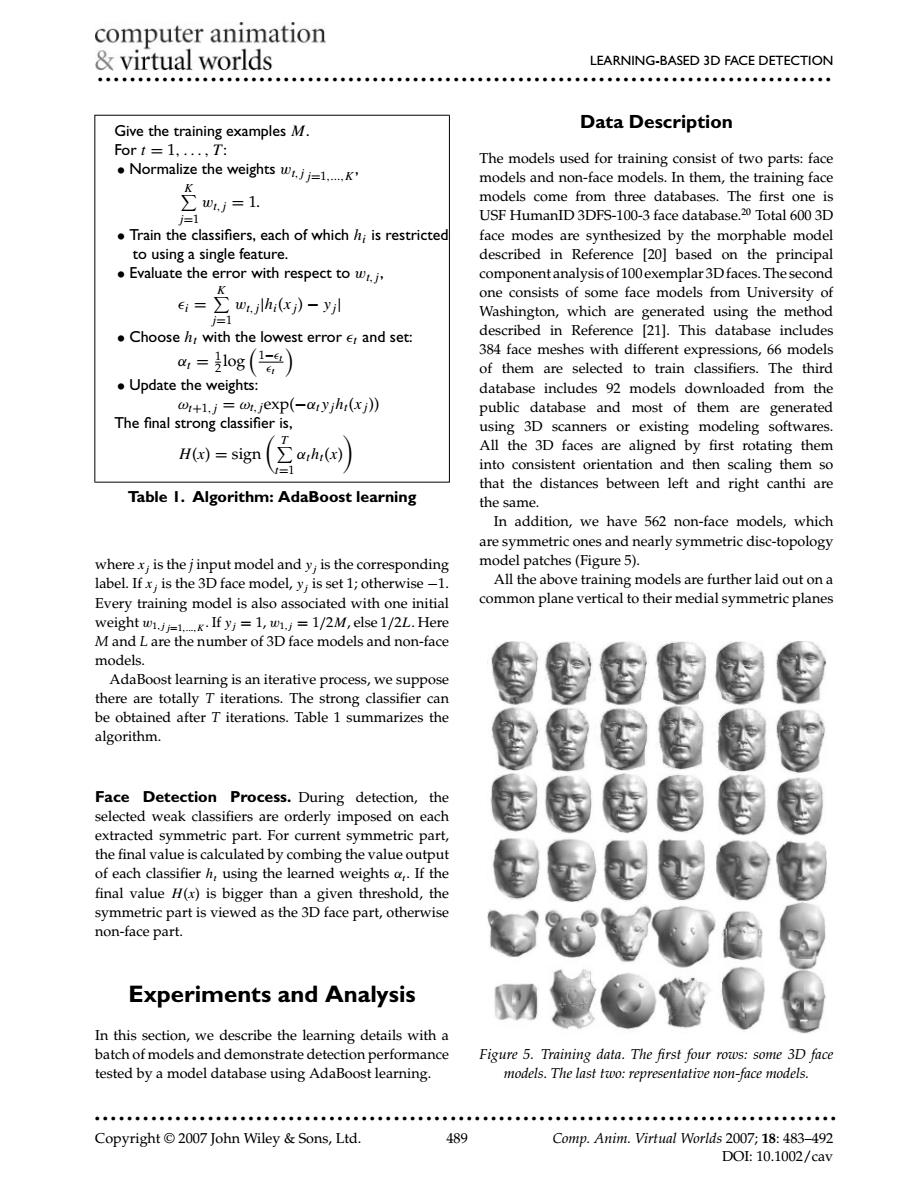正在加载图片...

computer animation virtual worlds LEARNING-BASED 3D FACE DETECTION 。。。。e。。。。。。e●。。。。....。。。。e。eee。e。e。。ee。e。。。。。ee。e。e。e。。eeee。ee。。。。。。。e。。。。。。。。。。。eee。。 Give the training examples M. Data Description For t=1,...,T: .Normalize the weights w.jj=1.. The models used for training consist of two parts:face models and non-face models.In them,the training face K wj=1. models come from three databases.The first one is j=1 USF HumanID 3DFS-100-3 face database.20 Total 600 3D Train the classifiers,each of which h;is restricted face modes are synthesized by the morphable model to using a single feature. described in Reference [20]based on the principal .Evaluate the error with respect to wi.j. component analysis of 100exemplar 3Dfaces.The second e=∑w.lh(c)-y one consists of some face models from University of j=1 Washington,which are generated using the method Choose h with the lowest error er and set: described in Reference [21].This database includes %=g(g) 384 face meshes with different expressions,66 models of them are selected to train classifiers.The third ·Update the weights: database includes 92 models downloaded from the @:+1.j=@t.jexp(-aryjhi(xj)) public database and most of them are generated The final strong classifier is, using 3D scanners or existing modeling softwares. H(x)=sign (x) All the 3D faces are aligned by first rotating them into consistent orientation and then scaling them so that the distances between left and right canthi are Table I.Algorithm:AdaBoost learning the same. In addition,we have 562 non-face models,which are symmetric ones and nearly symmetric disc-topology wherex;is the jinput model and y;is the corresponding model patches(Figure 5). label.If x,is the 3D face model,y;is set 1;otherwise-1. All the above training models are further laid out on a Every training model is also associated with one initial common plane vertical to their medial symmetric planes weight w1.jj1xIfy=1,w1.j=1/2M,else 1/2L.Here M and L are the number of 3D face models and non-face models. AdaBoost learning is an iterative process,we suppose there are totally T iterations.The strong classifier can be obtained after T iterations.Table 1 summarizes the algorithm. Face Detection Process.During detection,the selected weak classifiers are orderly imposed on each extracted symmetric part.For current symmetric part, the final value is calculated by combing the value output of each classifier h,using the learned weights a,.If the final value H(x)is bigger than a given threshold,the symmetric part is viewed as the 3D face part,otherwise non-face part. Experiments and Analysis In this section,we describe the learning details with a batch of models and demonstrate detection performance Figure 5.Training data.The first four rows:some 3D face tested by a model database using AdaBoost learning. models.The last two:representative non-face models. Copyright 2007 John Wiley Sons,Ltd. 489 Comp.Anim.Virtual Worlds 2007;18:483-492 DOL:10.1002/cavLEARNING-BASED 3D FACE DETECTION ........................................................................................... Give the training examples M. For t = 1,...,T : • Normalize the weights wt,jj=1,...,K, K j=1 wt,j = 1. • Train the classifiers, each of which hi is restricted to using a single feature. • Evaluate the error with respect to wt,j, i = K j=1 wt,j|hi(xj) − yj| • Choose ht with the lowest error t and set: αt = 1 2 log 1−t t • Update the weights: ωt+1,j = ωt,jexp(−αtyjht(xj)) The final strong classifier is, H(x) = sign T t=1 αtht(x) Table 1. Algorithm: AdaBoost learning where xj is the j input model and yj is the corresponding label. If xj is the 3D face model, yj is set 1; otherwise −1. Every training model is also associated with one initial weight w1,j j=1,...,K. If yj = 1, w1,j = 1/2M, else 1/2L. Here M and L are the number of 3D face models and non-face models. AdaBoost learning is an iterative process, we suppose there are totally T iterations. The strong classifier can be obtained after T iterations. Table 1 summarizes the algorithm. Face Detection Process. During detection, the selected weak classifiers are orderly imposed on each extracted symmetric part. For current symmetric part, the final value is calculated by combing the value output of each classifier ht using the learned weights αt. If the final value H(x) is bigger than a given threshold, the symmetric part is viewed as the 3D face part, otherwise non-face part. Experiments and Analysis In this section, we describe the learning details with a batch of models and demonstrate detection performance tested by a model database using AdaBoost learning. Data Description The models used for training consist of two parts: face models and non-face models. In them, the training face models come from three databases. The first one is USF HumanID 3DFS-100-3 face database.20 Total 600 3D face modes are synthesized by the morphable model described in Reference [20] based on the principal component analysis of 100 exemplar 3D faces. The second one consists of some face models from University of Washington, which are generated using the method described in Reference [21]. This database includes 384 face meshes with different expressions, 66 models of them are selected to train classifiers. The third database includes 92 models downloaded from the public database and most of them are generated using 3D scanners or existing modeling softwares. All the 3D faces are aligned by first rotating them into consistent orientation and then scaling them so that the distances between left and right canthi are the same. In addition, we have 562 non-face models, which are symmetric ones and nearly symmetric disc-topology model patches (Figure 5). All the above training models are further laid out on a common plane vertical to their medial symmetric planes Figure 5. Training data. The first four rows: some 3D face models. The last two: representative non-face models. ............................................................................................ Copyright © 2007 John Wiley & Sons, Ltd. 489 Comp. Anim. Virtual Worlds 2007; 18: 483–492 DOI: 10.1002/cav�������